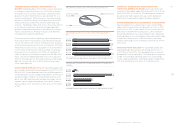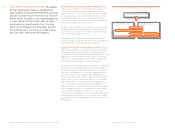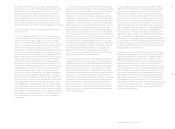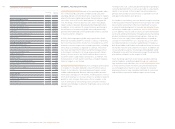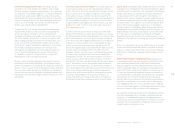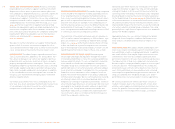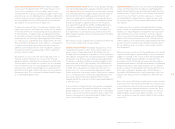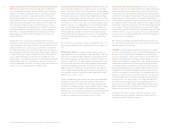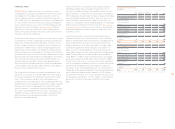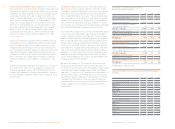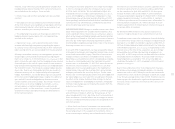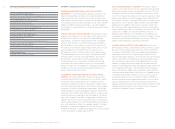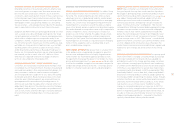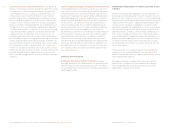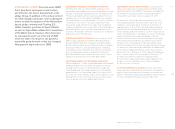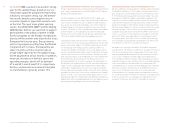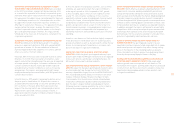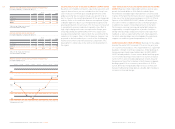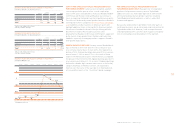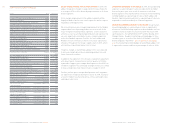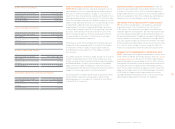Reebok 2007 Annual Report Download - page 117
Download and view the complete annual report
Please find page 117 of the 2007 Reebok annual report below. You can navigate through the pages in the report by either clicking on the pages listed below, or by using the keyword search tool below to find specific information within the annual report.113
ANNUAL REPORT 2007 --- adidas Group
03
However, many other fi nancial and operational variables that
could potentially reduce the effect from currency fl uctuations
are excluded from the analysis. These include:
- Interest rates and all other exchange rates are assumed
constant.
- Exchange rates are assumed at a year-end value instead
of the more relevant sales-weighted average fi gure, which we
utilize internally to better refl ect both the seasonality of our
business and intra-year currency fl uctuations.
- The underlying forecasted cash fl ow exposure (which the
hedge instrument mainly relates to) is not required to be
revalued in this analysis.
- Operational issues, such as potential discounts to key
accounts who have high transparency regarding the impacts
of currency on our sourcing activities (due to their own private
label sourcing efforts), are also excluded from this presentation.
Utilizing a centralized currency risk management system, our
Group hedges currency needs for projected sourcing require-
ments on a rolling 12- to 18-month basis. see Treasury, p. 091 Our
goal is to have the vast majority of our hedging volume secured
six months prior to the start of a given season. In rare instances,
long-term promotion partnership contracts are hedged beyond
the 18-month horizon. The Group also largely hedges balance
sheet risks. Due to our strong global position, we are able to
minimize currency risk to a large extent by utilizing natural
hedges. Nevertheless, our net US dollar exposure calculated
for the full current hedging period was roughly € 2.4 billion at
year-end 2007, which we hedged using forward contracts,
currency options and currency swaps. Our Group’s Treasury
Policy allows us to utilize hedging instruments, such as
currency options or option combinations, which provide
protection while – at the same time – retain the potential
to benefi t from future favorable exchange rate developments
in the fi nancial markets.
The Group increased the proportion of its longer-term hedges
in 2007, to strategically utilize the strong euro versus nearly
all other major currencies. We also employed a higher rate
of forward contracts to reduce option premiums. see Note 23,
p. 180 As 2008 hedging has almost been completed, it is clear
that exchange rates will be more favorable than those of 2007.
Correspond ingly, we believe that both the level and likelihood of
currency risk to our 2008 fi nancial contribution has declined
versus the prior year and is low overall.
INTEREST RATE RISKS Changes in market interest rates affect
future interest payments for variable-interest liabilities. As a
result, signifi cant interest rate increases can have an adverse
effect on the Group’s profi tability, liquidity and fi nancial position.
The acquisition of Reebok in 2006 led to an increase in interest
rate risks due to the higher fi nancing requirements and the
resulting higher weighted-average interest rate on the Group’s
fi nancing structure.
see Treasury, p. 091
In line with IFRS 7 requirements, we have analyzed the impact
of changes in the Group’s most important interest rates on net
income and shareholders’ equity. The effect of interest rate
changes on future cash fl ows is excluded from this analysis.
Nevertheless, accrued interest, which is recognized as a liability,
has been re-calculated based on the hypothetical market
interest rates as at December 31, 2007. Fair values for deriva-
tive interest rate instruments accounted for as cash fl ow
hedges were then re-evaluated based on the hypothetical
market interest rates with the resulting effects on net income
and equity included in the sensitivity analysis. The fair value
interest rate risk from private placements that are hedged with
fair value hedges was also taken into consideration. However,
the effect on the income statement from changes in the fair
values of hedged items and hedging instruments attributable
to interest rate changes was not material. Exclusions from this
analysis are as follows:
- Some fi xed-rate fi nancial assets, such as commercial paper
and certifi cates of deposit, which our Group values at “fair
value through profi t or loss” due to the short-term maturity of
these instruments. Potential effects due to changes in interest
rates are considered immaterial and are not recognized in the
sensitivity analysis.
- Other fi xed-rate fi nancial instruments are measured at
amortized cost. Since a change in interest rates would not change
the carrying amount of this category of instruments, there is
no net income impact and they are excluded from this analysis.
The interest rate sensitivity analysis assumes a parallel shift of
the interest yield curve for all currencies and was performed
on the same basis for both 2006 and 2007. A 100 basis point
increase in interest rates at December 31, 2007 would have
increased shareholders’ equity by € 6 million (2006: € 5 million)
and decreased net income by € 2 million (2006: € 2 million).
A 100 basis point decrease of the interest rates at December 31,
2007 would have resulted in a € 7 million decrease in share-
holders’ equity (2006: € 8 million) and a € 2 million increase in
net income (2006: € 2 million).
We believe the IFRS 7 interest rate analysis represents a
realistic if rough estimate of our current interest rate risk.
To moderate interest rate risks and maintain fi nancial fl exi bility,
a core tenet of our Group’s fi nancial strategy is to reduce fi nancial
leverage (i. e. net debt / shareholders’ equity) to under 50 %. In
2007, we strongly reduced net debt associ ated with the fi nancing
of the Reebok acquisition. see Treasury, p. 091 Capitalizing on low
interest rates at the time of the acquisition, we also strongly
increased the share of fi xed-rate fi nancing arrange ments in
early 2006. In 2007, we prioritized our debt reduction activities
on variable interest instruments. As a result, fi xed-rate fi nanc-
ing arrangements accounted for 70 % of our total debt out-
standing at December 31, 2007, compared to 65 % in the prior
year. see Treasury, p. 091
Due to these and various other risk compensation measures,
we believe we have made considerable progress on reducing
interest rate risks in 2007. Taking the current macroeconomic
situation into account, we do not anticipate a signifi cant change
in our Group’s average interest rate in 2008. Therefore, we con-
tinue to project the likelihood of signifi cant Group interest rate
increases, which could have a low fi nancial effect on our con-
tribution, as low.


